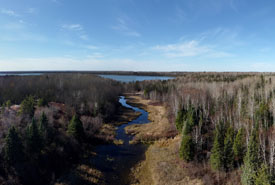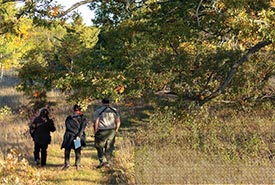How Canada can make up ground on its global nature goals

Boreal Wildlands, ON (Photo by NCC)
In April, the Nature Conservancy of Canada (NCC) announced its largest-ever project to protect private land. Covering nearly 1,500 square kilometres of boreal forest and wetlands in northern Ontario, the Boreal Wildlands marks a monumental shift in how we need to think of conservation in Canada. Granted, that project is a long way north from where I live in Peterborough, but I can already sense its impact.
Canada has resolved to protect 30 per cent of its lands and waters by 2030, as part of a global goal to protect biodiversity and counter the effects of climate change. Thirty per cent is the minimum, experts say, of what’s needed if we’re to save species on the brink of extinction and leverage nature to store carbon and help buffer us from the most severe impacts of climate change.
The twin crises of rapid biodiversity loss and climate change demand that we do more to protect nature, faster. Because, right now, we’re less than halfway to that 30 per cent goal, and the clock is ticking.
Everywhere I turn, the impacts of climate change are being discussed and experienced. The major storm that blew through Ontario and Quebec recently, and caused Peterborough to declare a state of emergency, is climate change in action. I am so motivated by the mission and work of NCC because protecting more nature is a proven natural solution to lessening the negative impacts of climate change that will help us weather the next storm. More intact nature absorbs and stores more carbon, and provides a wealth of powerful benefits that we all enjoy.
If done right, conservation can have a global impact. For example, the boreal forest that stretches from Newfoundland to the Yukon is the largest intact forest ecosystem on Earth. These trees and wetlands help our planet breathe. That’s why NCC chose to act and protect the Boreal Wildlands, near Hearst, Ontario.

Hazel Bird Nature Reserve, ON (Photo by Kristina Smith)
Good conservation can also inspire others. For instance, for over a decade NCC has worked to restore rare ecosystems at the Hazel Bird Nature Reserve, just south of where I live. The before-and-after images of restoration are astounding. In fact, they’re so impressive that a neighbour of the nature reserve this year decided he would donate his own land to NCC, because he witnessed first-hand the benefits that came from my NCC colleagues’ ecosystem stewardship next door.
Where invasive shrubs and Scots pine still clutter the newly donated land, NCC has been removing those species from the nature reserve in order to foster the native tall grass prairies and savannah ecosystems emblematic of the Rice Lake Plains, restoring much-needed habitat for a handful of at-risk species.
There are so many aspects to effective conservation — from restoration to sustainable use across the landscape, to working in partnership with Indigenous Peoples and local communities. NCC uses an evidence-based approach to conserve nature, protecting lands across Canada that support many species.
As Canada’s leading national non-profit private conservation organization, NCC is committed to playing a central role in the country’s conservation future — for the sake of our communities, our country and our planet. By mobilizing Canadians to join our conservation mission, we will accelerate the pace of conservation of our country’s most important habitats.
And that’s the key: acceleration. Conservation isn’t just for governments, Indigenous communities, non-profits and scientists — it’s something we all need to contribute to. And it’s something we need to do right now. In the past two years alone, NCC has influenced the protection of more than 1 million hectares (almost twice the size of Prince Edward Island), coast to coast to coast. Over the next few years, we will double our impact.
This National Environment Week, accelerating conservation will mean different things to different people. Some will plant native species in their yards and planters to support local biodiversity; many will likely tell their friends about their efforts. Others may donate to protect grasslands, forests, a peat bog or an estuary, and they may inspire others by sharing their generosity on social media. As for myself, I will work with my conservation colleagues across the country to pinpoint effective ways we can protect, restore and conserve hot spots for biodiversity in Canada. Together, we will accelerate the pace of conservation, celebrating our joint values of collaboration and measurable impact.
In the face of rapid biodiversity loss and climate change, nature is our ally. There is no solution to either without nature conservation. When nature thrives, we all thrive.


